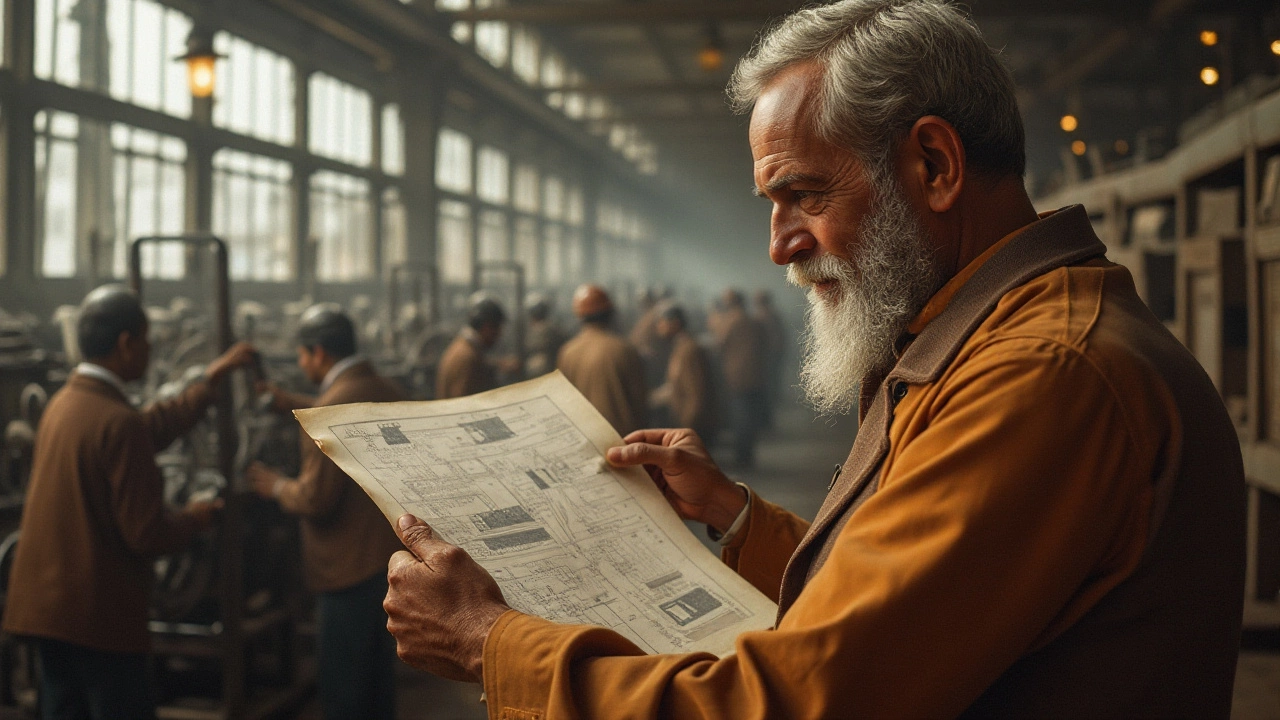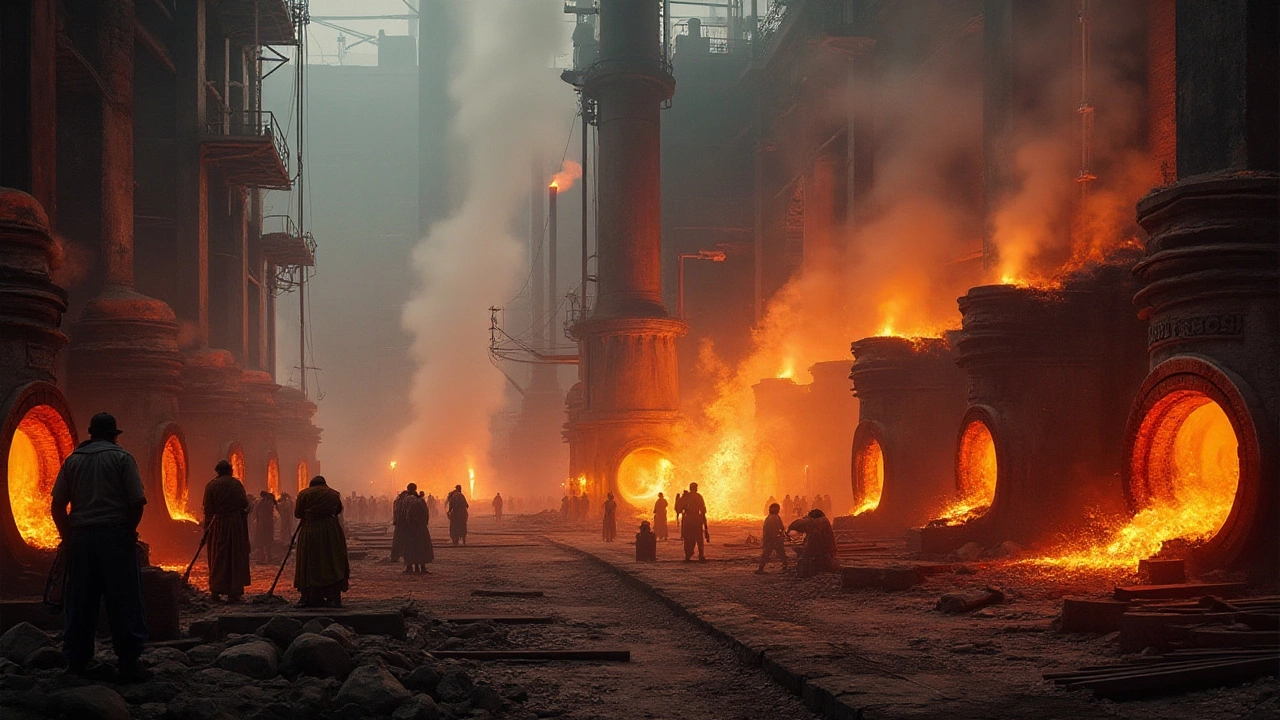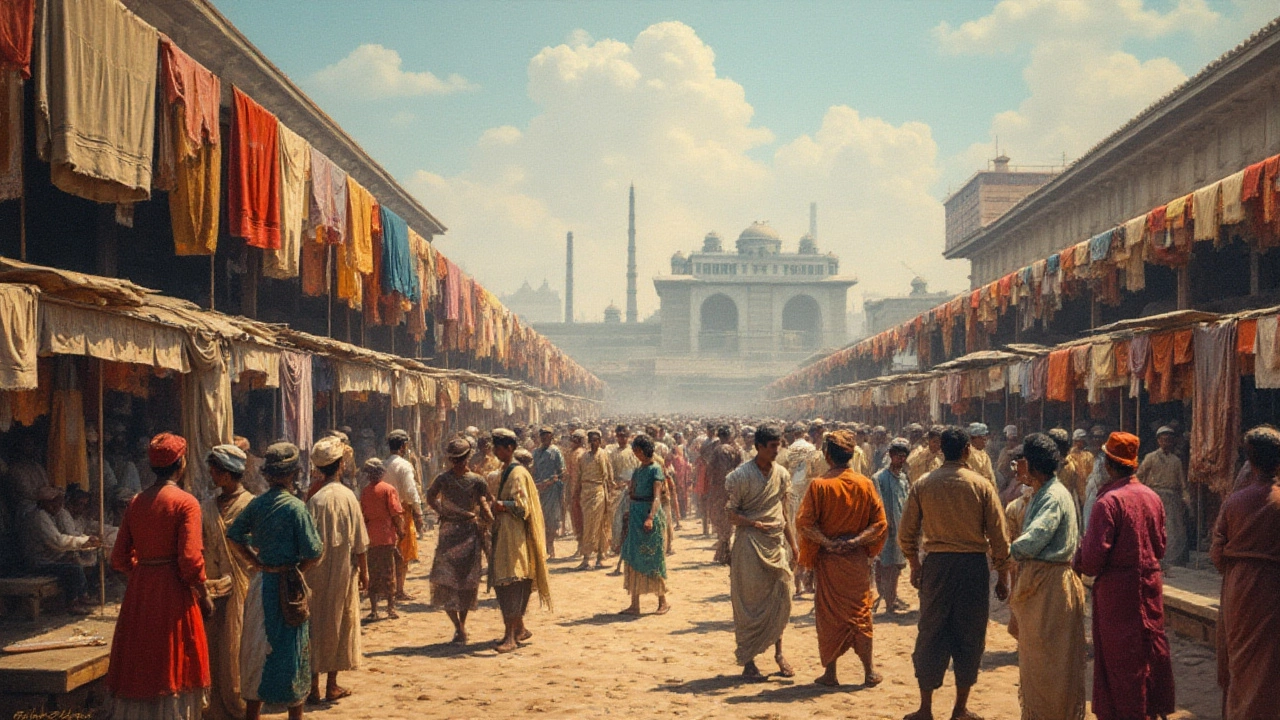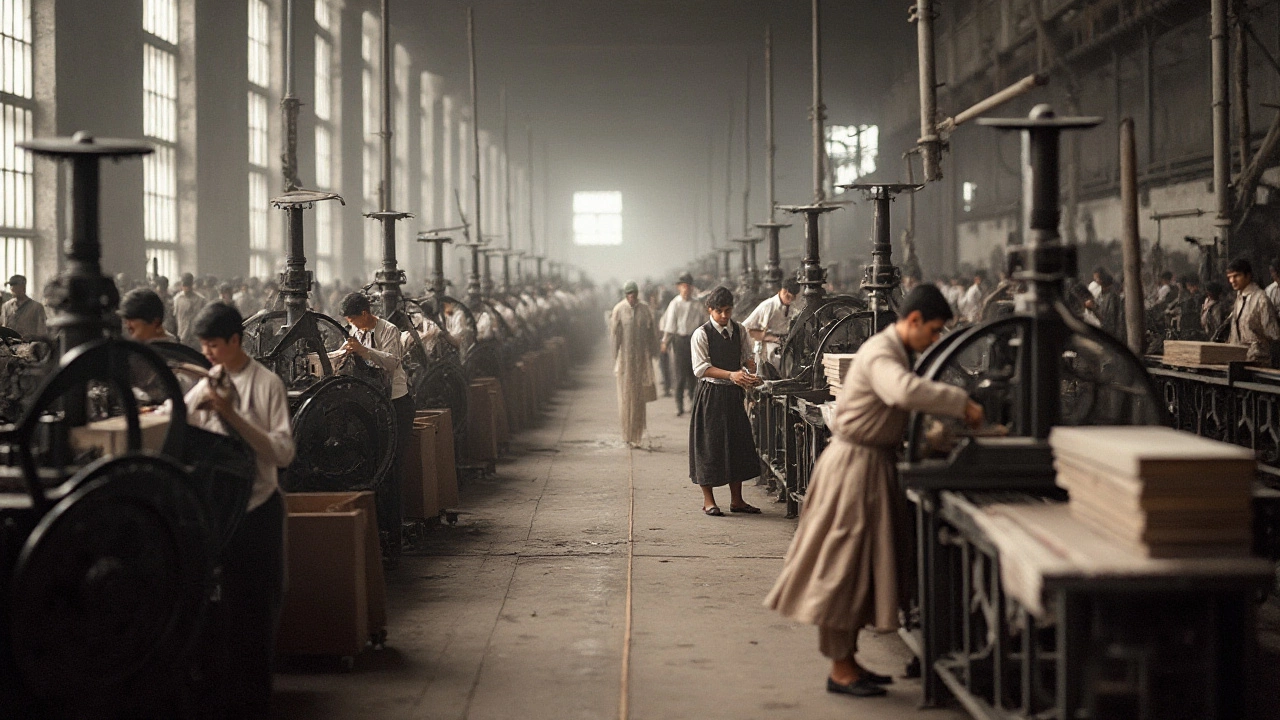The rise of the factory system marked a turning point in industrial history, propelling societies into a new era of manufacturing. As workers left cottage industries behind, they flocked to burgeoning factories that promised a novel power and efficiency.
At the heart of this transformation lay the ability to scale up production, lowering costs while boosting output to previously unimaginable levels. This article uncovers the rich tapestry of elements that constituted the factory system and highlights the significant economic benefits that came with its adoption.
From the role of emerging technological innovations to the structured organization of human labor, the factory system shaped modern industry in profound ways. Join us as we explore the reverberations of this industrial marvel and its enduring influence today.
- Origins of the Factory System
- Economic Advantages
- Impact on Labor and Society
- Legacy and Modern Comparisons
Origins of the Factory System
The factory system emerged as a revolutionary force during the late 18th century, largely fueled by the Industrial Revolution. This period saw a seismic shift in production methods, moving away from the traditional agrarian and handicraft economy towards industrial manufacturing. At its core, the factory system was predicated upon centralizing production operations within a single facility. This change was sparked in Britain, where a confluence of technological innovations and resource availability set the stage for transformation.
Key to the rise of the factory system were groundbreaking inventions such as the spinning jenny, water frame, and power loom, which dramatically enhanced cloth production efficiency. Richard Arkwright, heralded for establishing the first true water-powered cotton mill in 1771, played a pivotal role. His contributions to industrialization earned him the title of the 'Father of the Factory System.' By integrating these machines under one roof, manufacturers could exert greater control over quality and speed, drastically outpacing small-scale, home-based production systems.
Foremost among the advantages was the ability to exploit economies of scale. Factories optimized resource use and labor, channeling efforts into mass production. One could argue that such efficiency would have been unattainable without reorganizing labor in this structured environment. As noted by historian E.P. Thompson, "The factory became the ultimate form of work discipline." This rigid structure facilitated rapid advancements that propelled many Western economies into rapid growth.
Britain was uniquely positioned to pioneer the factory system. It enjoyed rich deposits of coal and iron ore, essential resources that powered and built the machinery. Additionally, the British political climate fostered economic growth with policies favoring burgeoning industries. This mix of factors, combined with an enterprising spirit, fostered conditions ripe for industrial innovation.
Interestingly, the factory system birthed a new urban workforce. Towns flourished as people migrated from rural areas in search of steady employment and the promise of better living standards. This new labor force faced a structured workday as long as 12 to 16 hours, a stark contrast to the irregular hours in agrarian life. The shift towards urban living catalyzed developments in housing, transportation, and public health, cementing the factory city as a key pillar of economic growth.
The influence of the factory system spread beyond Britain’s borders, rapidly adopted by other industrializing nations. Early adopters included the United States, Germany, and France, which capitalized on the efficiencies afforded by concentrated production. This monumental shift not only overhauled manufacturing but also sowed seeds for modern economic structures we witness today. Understanding these origins offers a window into the forces that shaped the industrial landscape, providing insights into the enduring legacy of the factory system.

Economic Advantages
The advent of the factory system during the Industrial Revolution marked an impressive shift in manufacturing, redefining productivity and shaping the very essence of modern industry. At its core, the system enabled mass production through the consolidation of manufacturing processes, leading to enhanced economies of scale. Factories centralized labor and brought together machines in a single location, creating a more organized and efficient production process. This centralization reduced transport costs between different stages of production, an efficiency that small-scale handicraft operations couldn’t offer. One of the most significant economic advantages was the ability to produce goods at a lower cost, allowing manufacturers to lower prices and cater to widening markets.
The rise of the factory also fueled technological advancements and encouraged innovation within these industrial hubs. Mechanization, notably with machines such as the power loom and the steam engine, transformed labor-intensive tasks into streamlined, high-speed operations. These technological wonders not only increased productivity but also decreased the requirement for skilled and manual labor, opening up job opportunities to a larger, less specialized workforce. Producing goods in large quantities made them accessible to a broader audience, enhancing consumer satisfaction and supporting the expansion of the middle class. Factories could meet increasing demand with predictable output, thus stabilizing prices and bringing a newfound prosperity to regions embracing this transformation.
"The factory system revolutionized not only production but also the social fabric of the time," remarked economic historian David S. Landes, emphasizing how this transformation influenced wider societal norms.
In addition to manufacturing capacity, the growth of the factory system catalyzed urban development. As factories set up in new towns and cities, they drew people from rural areas, promoting urbanization and the emergence of factory towns. This influx of workers created new housing demands, spurred retail and services, and drove economic growth. Cities became larger and more complex, with factories often at the heart of these burgeoning urban landscapes. The availability of jobs in these urban centers provided a strong pull factor, forever altering demographic trends and economic landscapes.
Moreover, the factory system encouraged new forms of managerial oversight and business organization. Owners and managers implemented structured work schedules and hierarchical labor divisions, a stark contrast to the informal arrangements of pre-factory labor. This structure brought about efficiency and discipline in production processes, optimizing the use of both human and material resources. As we delve into the transformational period marked by factories, it becomes evident that these innovations laid the groundwork for modern manufacturing techniques, proving indispensable in developing the growing worldwide economy.

Impact on Labor and Society
The advent of the factory system undoubtedly altered the very fabric of labor as individuals knew it, reconfiguring how work was perceived and done. These bustling production hubs became magnets for a burgeoning workforce, pulling people from rural areas into the throbbing heart of emerging industrial cities. This shift wasn’t just about new jobs in a factory, it was a seismic cultural change. People accustomed to the rhythm of agrarian life found themselves adapting to the whistle of factory timekeepers and the mechanical hum of a new era. The structure of labor evolved dramatically, divorcing work from the home and embedding it within the communal confines of factories.
In the new urban landscape, working conditions within many factories were often harsh, marked by long hours and minimal wages. Despite challenges, the promise of steady employment and a predictable income drew countless workers into factories, bringing with them aspirations of a better life. Labor unions began to sprout as collective responses to injustices faced by workers, setting the stage for critical social reforms.
One notable voice from this era, philosopher and economist Friedrich Engels, observed, "The advance of industry, whose pace has so accelerated since the invention of the steam engine, has transformed the aspect of society itself, it is not burgeoning towns that have brought forth industry, but industrialists with their machinery that have founded the modern towns."This quote reflects how industry reshaped both people’s lives and the environments they inhabited.
The factory system wasn’t just a nexus for economic activity; it became a crucible for social change. The workplace became a place of learning and skill development, albeit under often strained conditions. Technological advancements required workers to adapt and learn new skills, ushering in an era of specialization. In many ways, the factory system laid the groundwork for today’s knowledge-based economies, where continuous learning is pivotal. Additionally, the presence of industries in urban centers accelerated city growth, leading to a blend of diverse cultures and ideas. This urbanization also emphasized the need for public infrastructure, prompting governments to improve living conditions, education, and public services. Thus, the impact on society was profound, setting a course towards modernity and the societal frameworks we recognize today.

Legacy and Modern Comparisons
The factory system revolutionized the manufacturing landscape, leaving a lasting legacy that extends far beyond the industrial smoke and bustling assembly lines of the 18th and 19th centuries. This system not only redefined how goods were produced but also set the stage for modern industrial practices that we often take for granted today. As we draw comparisons between the past and present, it becomes clear how the foundational elements of the factory system persist, albeit in evolved forms. Today, the legacy of mass production is evident in every corner of the manufacturing sector, where centralized manufacturing plants drive economies of scale, allowing companies to produce at a magnitude that was once unfathomable. The rapid pace at which goods are produced and distributed is a testament to the enduring influence of those early factories.
As time has marched on, the advent of technology has broadened the capabilities of the original factory system. While steam engines and mechanized looms were groundbreaking during the Industrial Revolution, today's counterparts are robots and computer-controlled systems. These modern marvels provide precision and efficiency unimaginable to early industrialists, yet they stem directly from the seeds sown centuries ago. The integration of AI and IoT in manufacturing marks a new dawn for the industry, blending the principles of old with the state-of-the-art technology. This juxtaposition symbolizes an age where tradition meets innovation, forging a path forward where the principles of the past guide current and future advancements.
The historian Frederick Engels aptly remarked, "The factory system has given us the greatest material power, but the greatest material means does not guarantee enlightenment or progress unless it brings within it the seeds of growth." This sentiment captures the transformational essence of the system and its potential to either uplift societies or leave them mired in complexity and conflict, depending on how its power is harnessed.
The social implications of the factory system cannot be overstated. Though it spurred economic growth and increased accessibility to consumer goods, it also brought challenges such as labor disputes and socio-economic disparities—issues that, despite efforts in labor reform and rights advocacy, echo into today. Contemporary manufacturing sectors often grapple with similar challenges, albeit in different contexts, such as automation leading to workforce displacement. As industries balance efficiency with ethical responsibility, the comparison to the historical context offers insights into the complexities of modern industrial relations.
The modern-day factory has been shaped by several significant technological milestones. From the assembly line innovations of the early 20th century to the current arms race in digitalization, each leap has been influenced by the perennial quest for optimizing the manufacturing process. Companies nowadays invest heavily in innovative technologies with aspirations to stay competitive in a global market. This ongoing evolution underpins the legacy of the factory system, demonstrating how history molds the future, transforming industries with each stride forward.
| Era | Key Technological Milestone | Impact |
|---|---|---|
| 19th Century | Steam Power | Revolutionized transportation and production capabilities |
| 20th Century | Assembly Line | Significantly increased production speed and efficiency |
| 21st Century | AI and Robotics | Enhanced precision and reduced human error dramatically |

